The coming months are to be a period of celebration for the Royal Navy, with the UK's "senior service" marking the 100th anniversary of its first foray into aviation activities.
Personnel past and present will be looking back during a series of commemorative events, including air show appearances and a service of thanksgiving at St Paul's Cathedral in London. To be held early next month, the latter will also be an act of remembrance for the 6,000 British naval aviators to have lost their lives over the course of the last century.
"Fly Navy 100" will begin with a flypast over the aircraft carrier HMS Illustrious in Greenwich on 7 May; the same date when in 1909 The Admiralty placed an order for His Majesty's Airship 1, also named the "Mayfly".
Built by Vickers in Barrow-in-Furness, in north-west England, for a cost of almost £41,000 ($60,500), the dirigible's more than 155m (510ft) length made a major impression on the public of the day. Indeed Flight, which is also marking its centenary in 2009, reported in its 27 May 1911 issue: "At last our leviathan of the air has emerged from the interior of its hiding place into the full light of day."
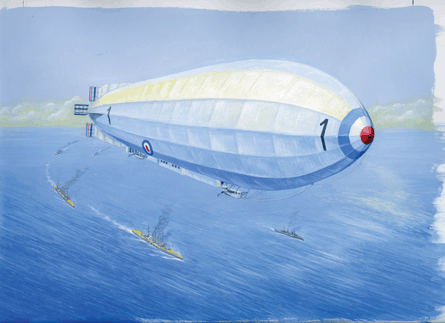 |
|---|
© Colin Paine |
Referring to the design's similarity to Germany's fearsome Graf Zeppelin, it added: "We will at least hope that the English version will be more fortunate." Sadly, it was not. The airship initially proved too heavy to fly and was modified to lighten its bulk, but broke when a gust of wind caught it when being moved from its hangar.
But such was the pace of early aerospace development that the Mayfly's potential had already been usurped. The RN's first four fixed-wing pilots completed training at RNAS Eastchurch on the Isle of Sheppey, Kent in 1911, and a British biplane performed the first take-off from a moving ship the following year.
Within the next decade came the First World War and many historic milestones, including the first land-attack raids launched from a ship at sea, attacks on enemy ships using air-dropped torpedoes, and landing on the deck of a ship under way. This period also saw air power used for the first time during a naval battle, at Jutland.
Flying service identities had yet to be fully established in the UK, and it was not until 1924 that the Fleet Air Arm name used today was first employed, albeit as an element of the Royal Air Force, which turned 90 last year.
Two of the most famous missions ever flown by RN crews came during the Second World War. Twenty Fairey Swordfish biplanes attacked the Italian surface fleet at anchor in Taranto harbour in November 1940, while nine "Stringbags" also disabled the German battleship Bismarck in 1941. The crucial nature of embarked aviation saw the UK at one point of the war operating 59 aircraft carriers.
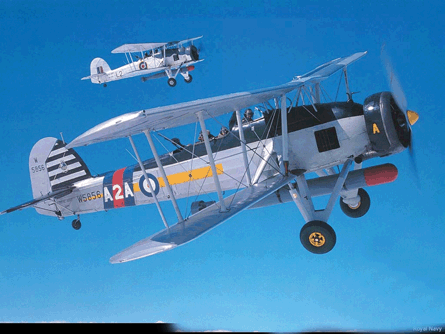 |
|---|
© Royal Navy |
British naval aviators then served during conflicts in Korea and Malaya in the early 1950s, flying types like the Hawker Sea Fury. The helicopter's emerging utility was also demonstrated in the latter campaign, using the navy's Westland Whirlwinds.
The post-Second World War years were also notable for the UK's innovation in the carrier aviation sector. Test pilot Eric Brown in 1945 performed the first carrier take-off and landing with a jet aircraft, using a de Havilland Sea Vampire. The steam catapult was also introduced in 1954, and is still used on big-deck carriers.
But for many people today, it is the memory of the Fleet Air Arm's activities during the 1982 Falklands War that exemplifies the skills of what is a numerically small, but highly operationally capable organisation.
Equipped with British Aerospace Sea Harrier FRS1 fighters, which had only been in squadron use for around three years before Argentina's invasion, a hastily prepared RN Task Force sailed for the South Atlantic to face occupying troops and a well-equipped enemy air force brandishing a small number of Exocet anti-ship missiles.
Fleet Air Arm and RAF pilots flew Sea Harriers from HMS Hermes and HMS Invincible during the campaign, with RAF Harrier GR3 ground-attack aircraft also used.
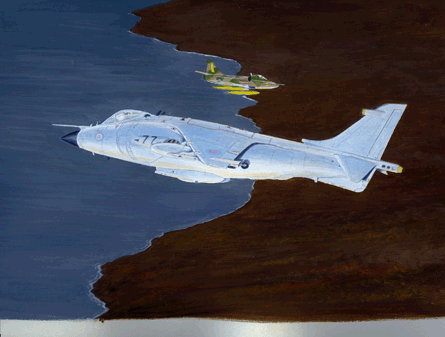 |
|---|
© Colin Paine |
Without the dominance of the "SHAR" against types including the Dassault Mirage V, English Electric Canberra, FMA IA-63 Pucara and McDonnell Douglas A-4 Skyhawk (depicted above), the outcome of the conflict could have been drastically different. The force scored 23 air-to-air kills without reply, with the FRS1's unique manoeuvrability, Blue Fox radar and Raytheon AIM-9L Sidewinder missiles having contributed greatly to the UK's success.
Later upgraded to the FA2 standard (below) and expanded by orders for new production aircraft, the Sea Harrier force went on to perform operations over Bosnia and Sierra Leone before falling victim to a spending review and retiring in March 2006. The UK's Joint Force Harrier (JFH) structure instead saw pilots from the RAF and RN share operational commitments using the former's Harrier GR7s, but away from the sea.
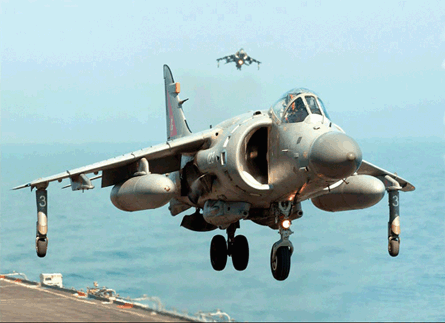 |
|---|
© Royal Navy |
Speaking at a Fly Navy 100 event in February, First Sea Lord Adm Sir Jonathon Band said: "They [the British government] made a very significant decision: that it was frankly impossible for this country to afford a quite separate RAF-owned force [of Harriers] and a navy-owned force for the carriers.
"They made a decision on a joint force that could be 'tooled up' to operate in both environments, but with the same purpose: to put metal down the target area," he says.
The early retirement of the navy's own fighter fleet proved a massively controversial gamble. It also drove the service's determination to bounce back with a stronger carrier strike capability than it has held since 1978, when it decommissioned the HMS Ark Royal and then retired its McDonnell Douglas Phantoms and Blackburn Buccaneers.
The Ministry of Defence last year signed a production contract for two 65,000t vessels to be named HMS Queen Elizabeth and HMS Prince of Wales, with its Future Aircraft Carrier (CVF) deal worth around £3.9 billion.
The project, along with the replacement of the RN's submarine-launched Trident nuclear deterrent, places the service at the heart of British defence policy for the next several decades, with the UK's largest ever warships expected to enter use from 2014 and 2016.
The navy's current three 22,500t CVS carriers - including the stored HMS Invincible, which will formally be retired later this year - enable it to support two small-scale "focused interventions" using air wings of between 10 and 20 Harrier GR9/9As. But with each CVF to carry an air wing of up to 40 aircraft, including 36 short take-off and vertical landing Lockheed Martin F-35Bs, the vessels will enable it to support a medium-scale conflict over a sustained period.
But the new carriers will come at a price, with their acquisition being balanced against smaller than anticipated buys of BAE-built Type 45 anti-air warfare destroyers armed with MBDA Sea Viper (Aster 30) surface-to-air missiles, and Astute-class submarines.
 |
|---|
© Colin Paine |
Some question the need for the UK to acquire such ships at a time of massive pressure on the MoD's procurement budget, largely caused by parallel combat commitments in Afghanistan and Iraq. But Band says: "I'm absolutely clear that while we are fighting one war we've got to be ready for the next set. We have got to have long-term investment as well as the short-term operational priority."
"This is a joint asset, not the flagship of the Royal Navy," adds an MoD official linked to the CVF project. "We can be 12 miles offshore without anyone's permission."
A template for future operations of the Joint Strike Fighter, JFH has maintained a close air support (CAS) capability at Afghanistan's Kandahar airfield since late 2004 using the Harrier GR7/9. "We haven't missed a sortie in four and a half years," says a senior RN pilot, adding: "We are the CAS platform of choice. Everyone wants a piece of Harrier."
The navy's 800 NAS, one of the structure's three frontline units along with the RAF's 1 and 4 squadrons, first deployed to Kandahar in October 2006. But the length of the Harrier's commitment has taken its toll on JFH's ability to perform tasks such as carrier-based operations, and RAF Panavia Tornado GR4s will take over within the coming months.
"I am very pleased that the Harriers are planned to have a break, so that they can get back on the ships," says Band. The UK will successfully transition to the JSF, "providing we can steward the next 10 years in giving enough flight experience from sea", he adds.
UK operations of the F-35B will be partly de-risked by the US Marine Corps putting STOVL aircraft aboard its amphibious ships well ahead of the RN. The UK's Qinetiq has also performed much supporting work using its VAAC Harrier testbed, including research into a shipborne rolling vertical landing technique, which will increase the weight at which the fighter can return aboard. The UK also earlier this year signed for its first three aircraft to be used during US-led initial operational test and evaluation of the JSF from 2011. It could buy 138 F-35s under its Joint Combat Aircraft project.
To support the resumption of carrier operations, the navy plans to re-establish 801 NAS in its own right next January; its personnel operate as a combined Naval Strike Wing with 800 NAS. The RAF's 20 Sqn operational conversion unit will also from mid-2009 spend time aboard a carrier for the first time as part of its training activities.
Today's Fleet Air Arm is a hard working organisation, with over 80% of its frontline squadrons deployed in locations as diverse as Afghanistan, Iraq, the Horn of Africa and the Caribbean. Senior officers say the current operational tempo is higher than that experienced at the end of the Second World War.
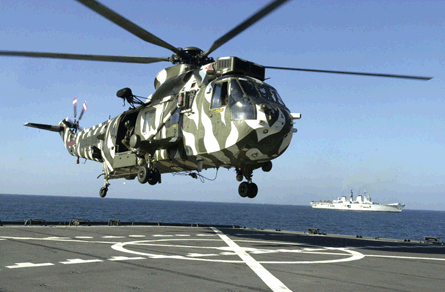 |
|---|
© Royal Navy |
The RN's Commando Helicopter Force is operating upgraded Westland Sea King HC4+ helicopters in Afghanistan, with the "Junglies" having also recently served in Iraq. Featuring composite Carson main rotor blades and a five-blade tail rotor, the aircraft have received a 20% performance increase under hot and high operating conditions.
The Sea King is in its 40th year of RN service, and under current plans some aircraft, such as Mk 7 Airborne Surveillance and Control examples, could fly until 2022.
This year also sees the 10th anniversary of the AgustaWestland AW101 Merlin HM1's entry into UK naval use. The multi-role aircraft is the subject of a Lockheed Martin UK-led Capability Sustainment Programme upgrade, which will support the type until at least 2029. Although built primarily for use as submarine hunters, RN Merlins also appear set for use in Afghanistan, with the first recently having received defensive aids system equipment for the overland mission.
AgustaWestland's Future Lynx, or "Wildcat", should make its first flight around November, and enter RN service during 2015 armed with new lightweight missiles. Replacements for the navy's Sea King 5 search and rescue helicopters are also due from 2012 under the joint MoD and UK Maritime and Coastguard Agency SAR-H contest, with the Eurocopter EC225 and Sikorsky S-92 in contention.
The navy's British Aerospace Jetstream T2 observer trainers will soon retire, and will be replaced by four Beechcraft King Air 350ERs under a UK Military Flying Training System deal with Cobham's FR Aviation.
In the longer term, the RN has also shown interest in a frigate-housed unmanned air vehicle capability for use during counter-drug operations in the Caribbean, and in an unmanned wide-area system for future over-the-horizon surveillance tasks, although neither are formal requirements at this time.
"Maritime aviation is there for the long haul," believes Band. "There will continue to be debate about how much, about manned and unmanned, and about ownership, but it's set fair."
Source: Flight International























